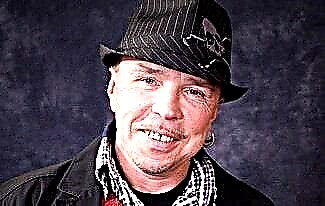Henry Ford (1863-1947) - American industrialist, owner of car factories around the world, inventor, author of 161 US patents.
With the slogan "a car for everyone", the Ford plant produced the cheapest cars at the beginning of the automotive era.

Ford was the first to use an industrial conveyor belt for in-line production of cars. The Ford Motor Company continues to exist today.
There are many interesting facts in the biography of Henry Ford, which we will talk about in this article.
So, here is a short biography of Ford.
Henry Ford biography
Henry Ford was born on July 30, 1863, into a family of Irish immigrants who lived on a farm near Detroit.
In addition to Henry, two more girls were born in the family of William Ford and Marie Lithogoth - Jane and Margaret, and three boys: John, William and Robert.
Childhood and youth
The parents of the future industrialist were very wealthy farmers. However, they had to put a lot of effort into cultivating the land.

Henry did not want to become a farmer because he believed that a person spends much more energy in managing a household than he receives fruits from his labor. As a child, he studied only in a church school, which is why his spelling was seriously lame and did not have much traditional knowledge.
An interesting fact is that in the future, when Ford was already a rich car manufacturer, he could not competently draw up a contract. Nevertheless, he believed that the main thing for a person is not literacy, but the ability to think.
At the age of 12, the first tragedy happened in the biography of Henry Ford - he lost his mother. Then, for the first time in his life, he saw a locomobile, which moved by means of a steam engine.
The car brought the teenager into indescribable delight, after which he was eager to connect his life with technology. However, the father was critical of his son's dream because he wanted him to become a farmer.
When Ford was 16 years old, he decided to run away from home. He left for Detroit, where he became an apprentice in a mechanical workshop. After 4 years, the guy returned home. During the day he helped his parents with the housework, and at night he invented something.
Watching how much effort his father spent to get the job done, Henry decided to make his job easier. He independently constructed a gasoline thresher.
Soon, many other farmers wanted to have a similar technique. This led to the fact that Ford sold the patent for the invention to Thomas Edison, and later began working for the company of the famous inventor.
Business
Henry Ford worked for Edison from 1891 to 1899. During this period of his biography, he continued to get involved in the design of technology. He set out to create a car that would be affordable for an ordinary American.
In 1893 Henry assembled his first car. Because Edison was critical of the automotive industry, Ford decided to leave his firm. Later he began to collaborate with the Detroit Automobile Company, but did not stay here for long either.
The young engineer sought to popularize his own car, as a result of which he began to ride the streets and appear in public places. However, many only mocked him, calling him "possessed" from Begley Street.
Nevertheless, Henry Ford did not give up and continued to look for ways to implement his ideas. In 1902 he took part in the races, having managed to reach the finish line faster than the reigning American champion. An interesting fact is that the inventor did not so much want to win the competition, but to advertise his car, which he actually achieved.

The very next year, Ford opened his own company "Ford Motor", where he began to produce cars of the "Ford A" brand. He still wanted to build a reliable and cheap car.
As a result, Henry was the first to use the conveyor for the production of cars - revolutionizing the automotive industry. This led to the fact that his company took a leading position in the automotive industry. Thanks to the use of the conveyor, the assembly of machines began to occur several times faster.
The real success came to Ford in 1908 - with the beginning of the production of the "Ford-T" car. This model was distinguished by its simple, reliable and relatively cheap price, which is what the inventor was striving for. It is interesting that every year the cost of "Ford-T" continued to decline: if in 1909 the price of a car was $ 850, then in 1913 it fell to $ 550!
Over time, the entrepreneur built the Highland Park plant, where the assembly line production took on an even larger scale. This further accelerated the assembly process and improved its quality. It is curious that if earlier a car of the "T" brand was assembled within about 12 hours, now less than 2 hours were enough for the workers!
Growing more and more wealthy, Henry Ford bought mines and coal mines, and also continued to build new factories. As a result, he created an entire empire that did not depend on any organizations and foreign trade.
By 1914, the industrialist's factories produced 10 million cars, which was 10% of all cars in the world. It is worth noting that Ford has always cared about the working conditions of the staff, and also constantly increased the wages of employees.
Henry introduced the nation's highest minimum wage, $ 5 a day, and built an exemplary workers' town. Curiously, the $ 5 "increased salary" was intended only for those who spent it wisely. If a worker, for example, drank money away, he was immediately dismissed from the enterprise.
Ford introduced one day off per week and one paid vacation. Although the employees had to work hard and adhere to strict discipline, the excellent conditions attracted thousands of people, so the businessman never looked for workers.
In the early 1920s, Henry Ford sold more cars than all of his competitors combined. An interesting fact is that out of 10 cars sold in America, 7 were produced at his factories. That is why during that period of his biography the man was nicknamed "the automobile king".
Since 1917, the United States participated in the First World War as part of the Entente. At the time, Ford's factories were producing gas masks, military helmets, tanks and submarines.

At the same time, the industrialist stated that he was not going to make money on the bloodshed, promising to return all the profits to the country's budget. This act was enthusiastically received by the Americans, which helped to raise his authority.
After the end of the war, sales of Ford-T cars began to decline sharply. This was because people wanted the variety that a competitor, General Motors, provided them. It got to the point that in 1927 Henry was on the verge of bankruptcy.
The inventor realized that he should create a new car that would interest the "spoiled" buyer. Together with his son, he introduced the Ford-A brand, which had an attractive design and improved technical characteristics. As a result, the auto industrialist again became a leader in the car market.

Back in 1925, Henry Ford opened Ford Airways. The most successful model among the liners was the Ford Trimotor. This passenger aircraft was produced in the period 1927-1933 and was used until 1989.
Ford advocated economic cooperation with the Soviet Union, which is why the first Soviet tractor of the Fordson-Putilovets brand (1923) was produced on the basis of the Fordson tractor. In subsequent years, Ford Motor workers contributed to the construction of factories in Moscow and Gorky.
In 1931, due to the economic crisis, Ford Motor products were in decreasing demand. As a result, Ford was forced not only to close some of the factories, but also to reduce the salaries of the working personnel. Outraged employees even tried to storm the Rouge factory, but the police dispersed the crowd using weapons.
Henry managed to find a way out of a difficult situation once again thanks to a new brainchild. He presented a sports car "Ford V 8", which could accelerate to 130 km / h. The car became very popular, which allowed the man to return to the previous sales volumes.
Political views and anti-Semitism
There are several dark spots in the biography of Henry Ford that were condemned by his contemporaries. So, in 1918 he became the owner of the newspaper The Dearborn Independent, where anti-Semitic articles began to be published a couple of years later.
Over time, a voluminous series of publications on this topic was combined into a book - "International Jewry". As time will tell, the ideas and appeals of Ford contained in this work will be used by the Nazis.
In 1921, the book was denounced by hundreds of famous Americans, including three American presidents. In the late 1920s, Henry admitted his mistakes and made a public apology in the press.
When the Nazis came to power in Germany, led by Adolf Hitler, Ford collaborated with them, providing material assistance. An interesting fact is that in the Munich residence of Hitler there was even a portrait of an auto industrialist.
It is no less interesting that when the Nazis occupied France, the Henry Ford plant, which produced cars and aircraft engines, was successfully operating in Poissy since 1940.
Personal life
When Henry Ford was 24 years old, he married a girl named Clara Bryant, who was the daughter of an ordinary farmer. The couple later had their only son, Edsel.
The couple lived a long and happy life together. Bryant supported and believed in her husband even when he was mocked. Once the inventor admitted that he would like to live another life only if Clara was next to him.

As Edsel Ford grew up, he became president of the Ford Motor Company, holding this position during his biography 1919-1943. - until his death.
According to authoritative sources, Henry was a Freemason. The Grand Lodge of New York confirms that the man was a member of Palestinian Lodge No. 357. He later received the 33rd degree of the Scottish Rite.
Death
After the death of his son in 1943 from stomach cancer, the elderly Henry Ford took over the company again. However, due to his old age, it was not easy for him to manage such a large empire.
As a result, the industrialist handed over the reins to his grandson Henry, who did an excellent job of his duties. Henry Ford died on April 7, 1947 at the age of 83. The cause of his death was a cerebral hemorrhage.
After himself, the inventor left his autobiography "My life, my achievements", where he outlined in detail the system of correct organization of labor at the plant. The ideas presented in this book have been adopted by many firms and organizations.
Photo by Henry Ford



















